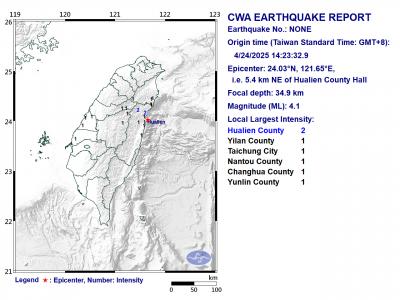The cancer risk in a Changhua village has been confirmed to be linked to a naphtha cracker in neighboring Yunlin County, a study published on Thursday showed.
The study focused on residents of Changhua’s Dacheng (大城) and Jhutang (竹塘) townships, north of Formosa Plastics Group’s naphtha cracker.
It found that cancer risk in Dacheng’s Taisi Village (台西) — about 8km from the plant in Yunlin’s Mailiao Township (麥寮) — rose from 1 in 1,000 between 1999 and 2007, to 8.44 in 1,000 between 2008 and 2014.
The study was conducted by researchers led by Chan Chang-chuan (詹長權), vice dean of National Taiwan University’s College of Public Health, from 2014 to last year. The team was commissioned by Changhua’s Public Health Bureau and the National Health Research Institutes.
Considering the latency of nine years for cancer and accounting for personal factors that could lead to cancer — including smoking and drinking — the research team told a news conference that the risk of cancer for Taisi villagers was found to be 2.66 times higher than residents in other villages in Dacheng since 2008, the 10th year of operations of the naphtha cracker.
Researchers also found that the cancer risk for Taisi villagers was 2.29 times higher than for those living in Jhutang, the team said.
The research found that “new cancer cases among Taisi residents were apparently related to the operations of the sixth naphtha cracker,” Chan told reporters.
Household registration information shows that Taisi has a population of about 1,300, although the number of people actually living there is said to be about 400.
Researchers analyzed the health data of 1,934 people with an average age of 59 and calculated their cancer risk.
The study showed that the concentration of heavy metals, such as vanadium, chromium, nickel, copper, arsenic, cadmium, thallium and lead, in the urine of residents of Taisi and Dingjhuang (頂庄) villages — both about 8km from the plant — were higher than among residents in Jhutang, about 20km from the plant.
It also found that a sour, sticky smell that Taisi residents often complained about came from high concentrations of formic acid, also possibly from the plant.
Although it has yet to determine which chemicals are behind the increase of cancer cases in Taisi, substances associated with formic acid are likely to cause chronic diseases or cancer, Chan said.
Changhua Public Health Bureau head Yeh Yen-po (葉彥伯) said his county is conducting follow-up health checks on residents with high concentrations of heavy metals in their urine, including tests for liver and lung cancer.
The Environmental Protection Administration (EPA) said it has dispatched surveillance vehicles to monitor the air quality near the plant for at least six months to determine if the plant is releasing hazardous levels of pollutants.
The EPA said it insepcted the smokestack in December, but found nothing unusual, adding that it will carry out another check soon.
The EPA said it would draft legislation aimed at regulating levels of hazardous air pollutants.

Chinese Nationalist Party (KMT) Chairman Eric Chu (朱立倫), spokeswoman Yang Chih-yu (楊智伃) and Legislator Hsieh Lung-chieh (謝龍介) would be summoned by police for questioning for leading an illegal assembly on Thursday evening last week, Minister of the Interior Liu Shyh-fang (劉世芳) said today. The three KMT officials led an assembly outside the Taipei City Prosecutors’ Office, a restricted area where public assembly is not allowed, protesting the questioning of several KMT staff and searches of KMT headquarters and offices in a recall petition forgery case. Chu, Yang and Hsieh are all suspected of contravening the Assembly and Parade Act (集會遊行法) by holding

PRAISE: Japanese visitor Takashi Kubota said the Taiwanese temple architecture images showcased in the AI Art Gallery were the most impressive displays he saw Taiwan does not have an official pavilion at the World Expo in Osaka, Japan, because of its diplomatic predicament, but the government-backed Tech World pavilion is drawing interest with its unique recreations of works by Taiwanese artists. The pavilion features an artificial intelligence (AI)-based art gallery showcasing works of famous Taiwanese artists from the Japanese colonial period using innovative technologies. Among its main simulated displays are Eastern gouache paintings by Chen Chin (陳進), Lin Yu-shan (林玉山) and Kuo Hsueh-hu (郭雪湖), who were the three young Taiwanese painters selected for the East Asian Painting exhibition in 1927. Gouache is a water-based

Taiwan would welcome the return of Honduras as a diplomatic ally if its next president decides to make such a move, Minister of Foreign Affairs Lin Chia-lung (林佳龍) said yesterday. “Of course, we would welcome Honduras if they want to restore diplomatic ties with Taiwan after their elections,” Lin said at a meeting of the legislature’s Foreign Affairs and National Defense Committee, when asked to comment on statements made by two of the three Honduran presidential candidates during the presidential campaign in the Central American country. Taiwan is paying close attention to the region as a whole in the wake of a

A magnitude 4.1 earthquake struck eastern Taiwan's Hualien County at 2:23pm today, according to the Central Weather Administration (CWA). The epicenter of the temblor was 5.4 kilometers northeast of Hualien County Hall, at a depth of 34.9 km, according to the CWA. The earthquake's intensity, which gauges the actual effect of a temblor, was the highest in Hualien County, where it measured 2 on Taiwan's 7-tier intensity scale. The quake also measured an intensity of 1 in Yilan county, Taichung, Nantou County, Changhua County and Yunlin County, the CWA said. There were no immediate reports of damage or injuries.